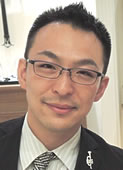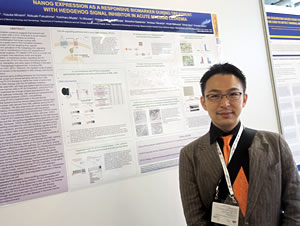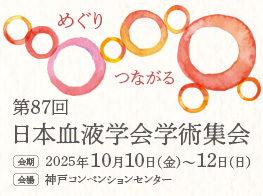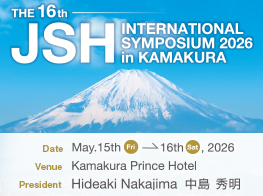
名前:垣内 誠司【神戸大学医学部 腫瘍・血液内科】
発表日時:2016年6月11日
発表形式:ポスター
Title:
NANOG expression as a responsive biomarker during treatment with Hedgehog signal inhibitor in acute myeloid leukemia
Authors:
Seiji Kakiuchi1, Yosuke Minami2, Nobuaki Fukushima3, Yoshiharu Miyata1, Yu Mizutani1, Hideaki Goto1, Keiji Kurata1, Shinichiro Kawamoto1, Kimikazu Yakushijin1, Hiroshi Matsuoka1, Tomoki Naoe4, Hironobu Minami1
Affiliations:
1Department of Medical Oncology and Hematology, Kobe University Hospital, Kobe, 2Department of Transfusion Medicine and Cell Therapy, Kobe University Hospital, Kobe, 3Department of Hematology and Oncology, Nagoya University Graduate School of Medicine, Nagoya, 4National Hospital Organization Nagoya Medical Center, Nagoya, Japan
Abstract:
Background
Cumulative evidence suggests that dormant self-renewing leukemic stem cells (LSCs) contribute to acute myeloid leukemia (AML) propagation and relapse by evading conventional chemotherapies that target cycling cells. Therefore, there is a great need to find innovative therapies for AML that eliminate LSCs by targeting their specific properties. Aberrant activation of the Hedgehog (Hh) signaling pathway is involved in maintenance of the LSC populations in several experimental systems. PF-0444913 (PF-913) is a novel oral small molecule inhibitor that selectively binds and targets Smoothened (SMO), a membrane protein regulating the Hh pathway. Treatment with PF-913 has shown promising results regarding safety, tolerability, and early signs of efficacy in the early phase study of hematologic malignancies, including AML (Jamieson, et al. ASH, 2011). However, the detailed mode of action and biomarkers remain to be elucidated in AML therapy with the Hh pathway inhibitors.
Aims
We examined gene profiling analyses and biomarkers using the pre-clinical model and clinical samples derived from AML patients during PF-913 therapy to clarify the mode of action and biomarkers in AML therapy with the Hh pathway inhibitors.
Methods
We used AML cell lines and patient-derived primary AML cells and bone marrow cells in PF-913 treatment. Using RQ-PCR assays, we examined the change of gene expressions in the canonical Hh pathway molecules. We carried out comprehensive gene set enrichment analysis (GSEA), and pathway analysis during PF-913 treatment both in the pre-clinical experimental systems and the clinical setting (bone marrow blast-rich mononuclear cells derived from AML patients during the PF-913 mono-therapy). We also examined cell cycle analyses using flow-cytometry, immunoblot and immuno-staining assays.
Results
In the immunodeficient NOD/SCID/IL2rgnull(NOG) mouse model and the ex vivo culturing system of AML cell lines, GSEA revealed that PF-913 treatment induced effects on the self-renewal signatures and the cell-cycling regulations associated with LSC-like properties. Moreover, GSEA revealed that PF-913 treatment in the clinical setting modulated the LSC-like signature, the cell-cycling regulation signature, and the chemokine activity signature in the AML bone marrow cells. Ki-67 immuno-staining of bone marrow derived from AML patients showed that PF-913 treatment temporarily increased cell-cycling status during shorter periods of treatment. We also examined the pluripotency factor, Nanog expression in bone marrow cells derived from AML patients during the PF-913 therapy, based on the previous report that downstream effectors in the Hh pathway, GLI1 and GLI2, directly bind to the Nanog promoter and that the GLI-Nanog axis promotes stemness and growth in several cancers. Change of Nanog transcripts was closely associated with the GLI-target genes in bone marrow blast-rich mononuclear cells derived from AML patients during the PF-913 therapy. Furthermore, by backing to the pre-clinical experimental systems, Nanog transcript level stringently and significantly decreased during PF-913 treatment. In the same pre-clinical model, immunoblot resulted PF-913 treatment decreased the expression of Nanog protein level, too. Transfection with siRNA targeting SMO downregulated expression of Nanog protein level as well.
Summary/Conclusion
Gene profiling analyses revealed that treatment with Hh signaling inhibitor, PF-913 modulates self-renewal and cell-cycling signatures in AML, and Nanog transcript can be a responsive biomarker during the therapy. Our findings imply that PF-913 treatment can improve AML therapy through sensitizing dormant LSCs to chemotherapy and overcoming residual LSC-like diseases in the bone marrow microenvironment.
EHA2016参加レポート
このたびは21th EHA congressでの発表にあたりEHA travel awardに採択いただき有難うございました。本学会はコペンハーゲンのBella Centerで開催されましたが、昨年末発表したオーランドでのASHと比べると規模は半分以下で移動も容易でした。また大ホールでの口演は患者数の多い西欧のためか新規薬剤のトピックが著しいためか、CLLに関するセッションが多くみられました。ASHは非常に大きな会場で基礎研究はpreliminaryな報告も多くて雑多な印象でしたが、EHAはほどよい規模である程度結果がまとまってから報告されたものが多く、採択率も低いことからクオリティーの高い発表が多かったように感じられました。
私はポスターセッションにて急性骨髄性白血病に対するHedgehogシグナル阻害薬の作用のメカニズム解明に関するトランスレーショナルリサーチの結果を発表いたしました。急性骨髄性白血病やいくつかの癌腫ではHedgehogシグナルの活性化されていますが、急性骨髄性白血病では最近phase Iで阻害薬の安全性が報告されたものの、その作用のメカニズムは詳しくわかっていません。当研究では治験患者の骨髄検体を用いて遺伝子プロファイル解析を行い、本薬剤がcell cycleの制御および自己複製能のシグネチャーに影響を与えることを示しました。以前に当グループにて行っている免疫不全マウスを用いたin vivoでの研究でも同じシグネチャーに変化が表れており、特に自己複製能を示す分子であるNANOGの発現に着目しました。治験患者での治療前後で骨髄の免疫染色でNANOGの染色の程度は低下しており、骨髄液のRT-qPCRでも発現の低下が速やかに認められました。このことから、Sonic Hedgehog ligandを強制発現するストローマと白血病細胞株を共培養したin vitroの系を用いて解析したところ、RT-qPCRやwestern blotでNANOGの低下がみられ当薬剤が自己複製能を標的とした作用を持ち、NANOGが治療反応性のバイオマーカーになり得ることを示しました。白血病に対する従来の化学療法では白血病幹細胞の残存が難治・再発の原因となるため幹細胞を標的とした治療が必要であり、本薬剤がその治療の一端となる得ることを示した意義深いものであると考えております。ポスターディスカッションでも興味をもっていただき、論文化を進める上での課題点も明確となり有意義な時間となりました。
学会では腫瘍免疫に関して興味深いものが多くみられました。再発性AMLに対するazacitidineとnivolumabの併用のphase Iでのポスターでの報告は少数例ながらhistorical controlと比べPFSは有意差があり、OSでの有意差はないものの改善傾向であるとされ注目を集めていました。またresponderはnon-responderに比べてTregが有意に少なくCD8+CTLが多いというデータも示されており、腫瘍免疫の惹起をいかに効果的に起こすかが課題となると思われます。また、移植後再発も含めた再発難治性CD19+B-ALLに対するCAR-T療法の口演発表では高腫瘍量でも80%弱とする極めて高いCR率が得られるものの1年以上の無病再発率は27%にとどまるなど再発が多く、いかに長期的に抗腫瘍効果を得られるようにするかが課題になりそうです。今後ますます血液腫瘍に対する治療でも腫瘍免疫を効果的に惹起することが、実地診療において求められるようになる時代の潮流を感じました。
最後に採用いただきました日本血液学会国際委員会の諸先生方、事務局の皆様、そして南博信教授や南陽介先生をはじめいつも温かくご指導いただく医局の皆様に深謝いたします。




